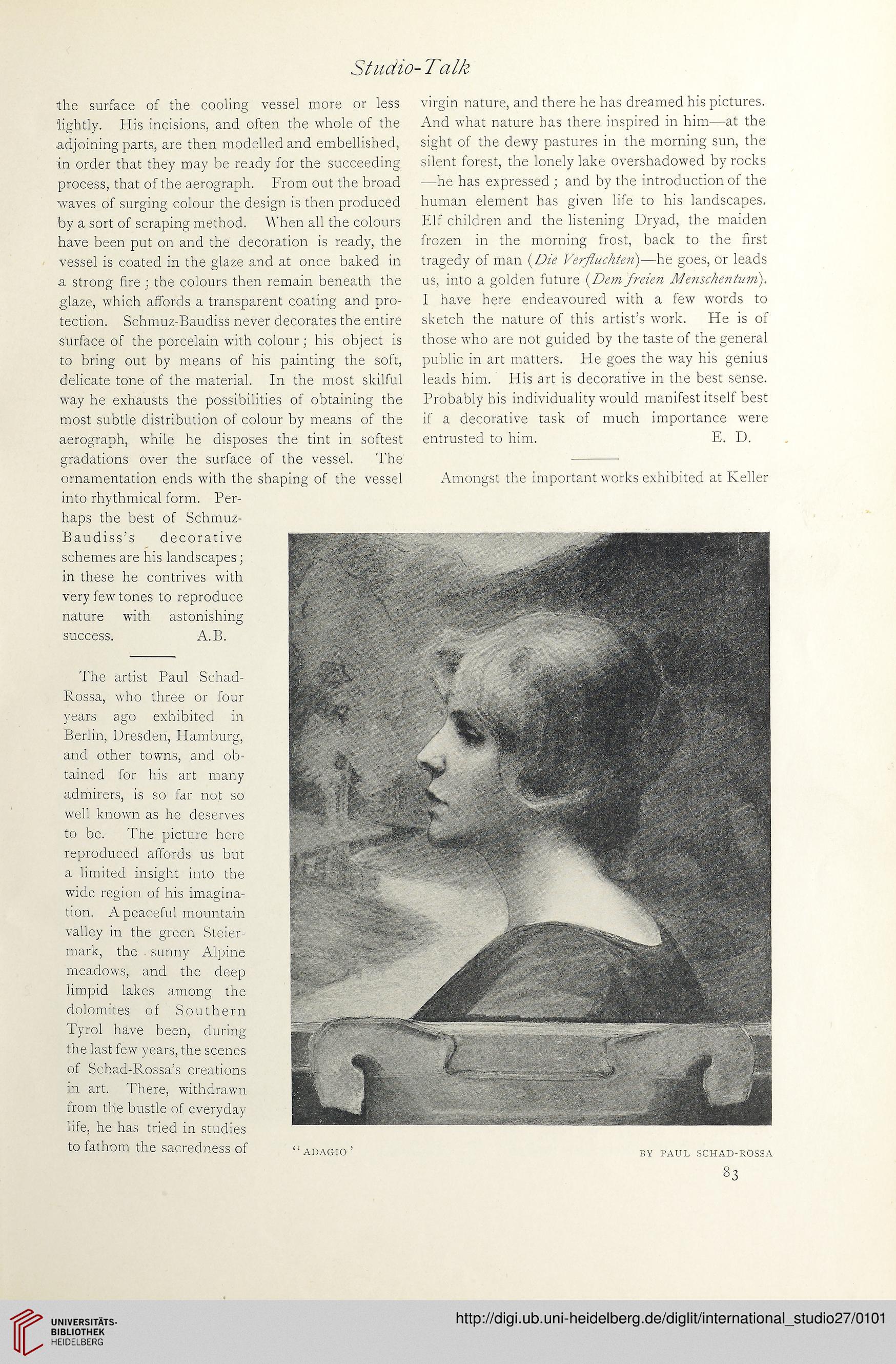Studio-Talk
the surface of the cooling vessel more or less
‘lightly. His incisions, and often the whole of the
adjoining parts, are then modelled and embellished,
in Order that they may be ready for the succeeding
process, that of the aerograph. From out the broad
waves of surging colour the design is then produced
by a sort of scraping method. When all the colours
have been put on and the decoration is ready, the
vessel is coated in the glaze and at once baked in
a strong fire ; the colours then remain beneath the
glaze, which affords a transparent coating and pro-
tection. Schmuz-Baudiss never decorates the entire
surface of the porcelain with colour; his object is
to bring out by means of his painting the soft,
delicate tone of the material. In the rnost skilful
way he exhausts the possibilities of obtaining the
most subtle distribution of colour by means of the
aerograph, while he disposes the tint in softest
gradations over the surface of the vessel. The
ornamentation ends with the shaping of the vessel
into rhythmical form. Per-
haps the best of Schmuz-
Baudiss’s decorative
schemes are his landscapes ;
in these he contrives with
very few tones to reproduce
nature with astonishing
success. A.B.
The artist Paul Schad-
Rossa, who three or four
years ago exhibited in
Berlin, Dresden, Hamburg,
and other towns, and ob-
tained for his art many
admirers, is so far not so
well known as he deserves
to be. The picture here
reproduced affords us but
a limited insight into the
wide region of his imagina-
tion. Apeaceful mountain
valley in the green Steier-
mark, the sunny Alpine
meadows, and the deep
limpid lakes among the
dolomites of Southern
Tyrol have been, during
the last few years, the scenes
of Schad-Rossa’s Creations
in art. There, withdrawn
from the bustle of everyday
life, he has tried in studies
to fathom the sacredness of
virgin nature, and there he has dreamed his pictures.
And what nature has there inspired in him—at the
sight of the dewy pastures in the morning sun, the
silent forest, the lonely lake overshadowed by rocks
—he has expressed ; and by the introduction of the
human element has given life to his landscapes.
Elf children and the listening Dryad, the maiden
frozen in the morning frost, back to the first
tragedy of man {Die Verfluchten)—he goes, or leads
us, into a golden future {Dem freien Menschentum).
I have here endeavoured with a few words to
sketch the nature of this artist’s work. He is of
those who are not guided by the taste of the general
public in art matters. He goes the way his genius
leads him. His art is decorative in the best sense.
Probably his individuality would manifest itself best
if a decorative task of much importance were
entrusted to him. E. D.
Amongst the important works exhibited at Keller
the surface of the cooling vessel more or less
‘lightly. His incisions, and often the whole of the
adjoining parts, are then modelled and embellished,
in Order that they may be ready for the succeeding
process, that of the aerograph. From out the broad
waves of surging colour the design is then produced
by a sort of scraping method. When all the colours
have been put on and the decoration is ready, the
vessel is coated in the glaze and at once baked in
a strong fire ; the colours then remain beneath the
glaze, which affords a transparent coating and pro-
tection. Schmuz-Baudiss never decorates the entire
surface of the porcelain with colour; his object is
to bring out by means of his painting the soft,
delicate tone of the material. In the rnost skilful
way he exhausts the possibilities of obtaining the
most subtle distribution of colour by means of the
aerograph, while he disposes the tint in softest
gradations over the surface of the vessel. The
ornamentation ends with the shaping of the vessel
into rhythmical form. Per-
haps the best of Schmuz-
Baudiss’s decorative
schemes are his landscapes ;
in these he contrives with
very few tones to reproduce
nature with astonishing
success. A.B.
The artist Paul Schad-
Rossa, who three or four
years ago exhibited in
Berlin, Dresden, Hamburg,
and other towns, and ob-
tained for his art many
admirers, is so far not so
well known as he deserves
to be. The picture here
reproduced affords us but
a limited insight into the
wide region of his imagina-
tion. Apeaceful mountain
valley in the green Steier-
mark, the sunny Alpine
meadows, and the deep
limpid lakes among the
dolomites of Southern
Tyrol have been, during
the last few years, the scenes
of Schad-Rossa’s Creations
in art. There, withdrawn
from the bustle of everyday
life, he has tried in studies
to fathom the sacredness of
virgin nature, and there he has dreamed his pictures.
And what nature has there inspired in him—at the
sight of the dewy pastures in the morning sun, the
silent forest, the lonely lake overshadowed by rocks
—he has expressed ; and by the introduction of the
human element has given life to his landscapes.
Elf children and the listening Dryad, the maiden
frozen in the morning frost, back to the first
tragedy of man {Die Verfluchten)—he goes, or leads
us, into a golden future {Dem freien Menschentum).
I have here endeavoured with a few words to
sketch the nature of this artist’s work. He is of
those who are not guided by the taste of the general
public in art matters. He goes the way his genius
leads him. His art is decorative in the best sense.
Probably his individuality would manifest itself best
if a decorative task of much importance were
entrusted to him. E. D.
Amongst the important works exhibited at Keller




